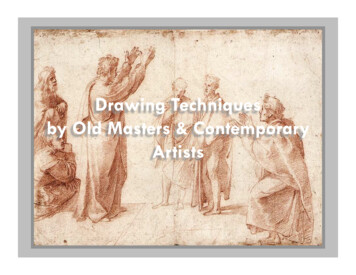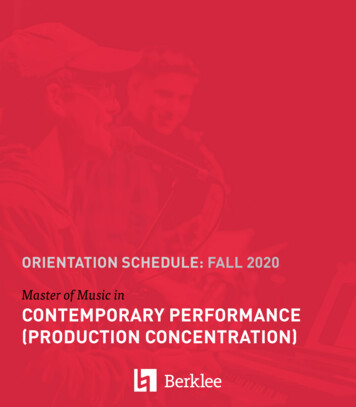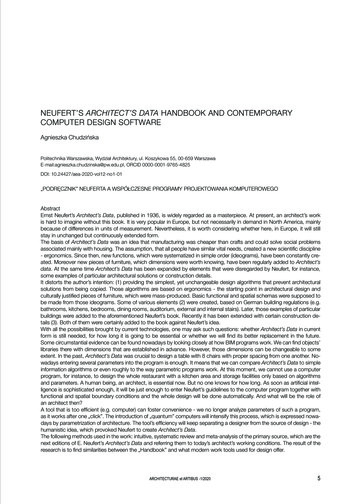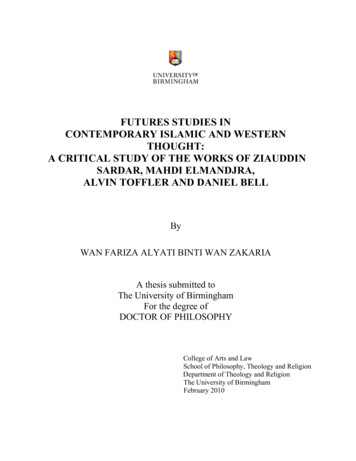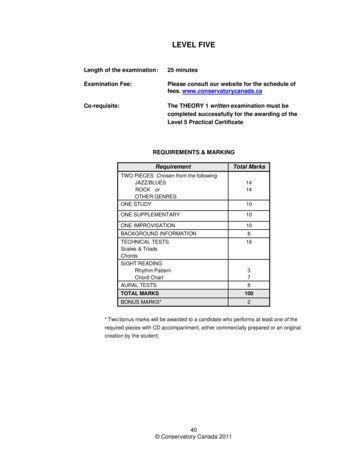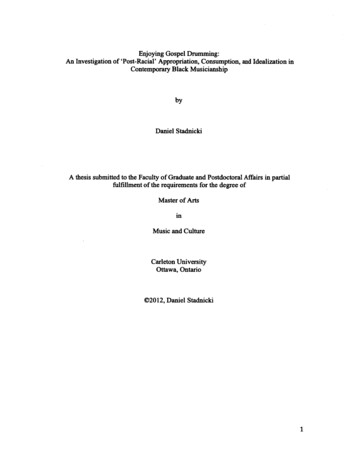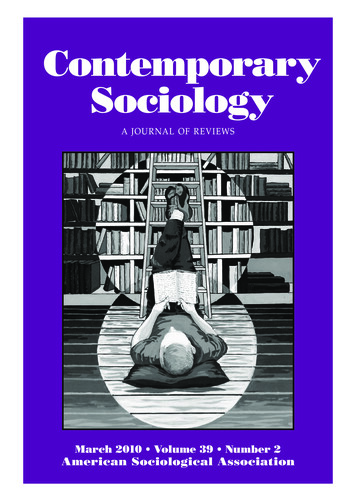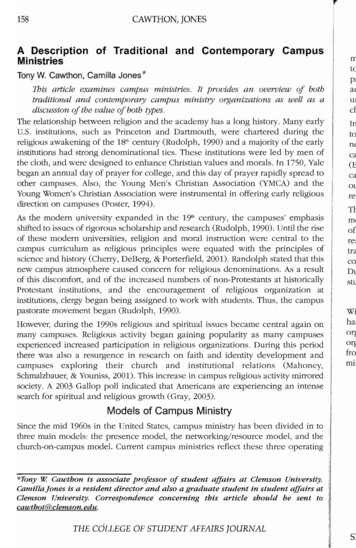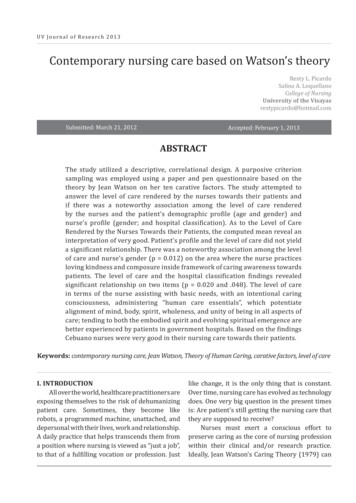
Transcription
UV Journal of Research 2013Contemporary nursing care based on Watson’s theorySubmitted: March 21, 2012Resty L. PicardoSalina A. LoquellanoCollege of NursingUniversity of the Visayasrestypicardo@hotmail.comABSTRACTAccepted: February 1, 2013The study utilized a descriptive, correlational design. A purposive criterionsampling was employed using a paper and pen questionnaire based on thetheory by Jean Watson on her ten carative factors. The study attempted toanswer the level of care rendered by the nurses towards their patients andif there was a noteworthy association among the level of care renderedby the nurses and the patient’s demographic profile (age and gender) andnurse’s profile (gender; and hospital classification). As to the Level of CareRendered by the Nurses Towards their Patients, the computed mean reveal aninterpretation of very good. Patient’s profile and the level of care did not yielda significant relationship. There was a noteworthy association among the levelof care and nurse’s gender (p 0.012) on the area where the nurse practicesloving kindness and composure inside framework of caring awareness towardspatients. The level of care and the hospital classification findings revealedsignificant relationship on two items (p 0.020 and .048). The level of carein terms of the nurse assisting with basic needs, with an intentional caringconsciousness, administering “human care essentials”, which potentiatealignment of mind, body, spirit, wholeness, and unity of being in all aspects ofcare; tending to both the embodied spirit and evolving spiritual emergence arebetter experienced by patients in government hospitals. Based on the findingsCebuano nurses were very good in their nursing care towards their patients.Keywords: contemporary nursing care, Jean Watson, Theory of Human Caring, carative factors, level of careI. INTRODUCTIONAll over the world, healthcare practitioners areexposing themselves to the risk of dehumanizingpatient care. Sometimes, they become likerobots, a programmed machine, unattached, anddepersonal with their lives, work and relationship.A daily practice that helps transcends them froma position where nursing is viewed as “just a job”,to that of a fulfilling vocation or profession. Justlike change, it is the only thing that is constant.Over time, nursing care has evolved as technologydoes. One very big question in the present timesis: Are patient’s still getting the nursing care thatthey are supposed to receive?Nurses must exert a conscious effort topreserve caring as the core of nursing professionwithin their clinical and/or research practice.Ideally, Jean Watson’s Caring Theory (1979) can
134UV Journal of Researchbe viewed as pivotal to this objective. It embodiesthe prototype of what an idyllic nurse shouldbe. Watson mentioned that the key essentialsof her theory are the: (1) carative features; (2)transpersonal caring affiliation; and (3) the caringincident or moment. She believes that the practiceof caring is the most essential idea of nursing. It isthe unifying focus for practice (Vanguard HealthSystems, 2010).The intention of the research is to constructa superior thought and application of the theoryof Jean Watson to the recent nursing care. Basedon a reflection of the researchers’ experienceslast year, the one of the researchers for instance,has assumed the role of a patient for a time. Itwas observed that the nurse-client relationshiphas greatly changed. Over time the nurseclient interaction has diminished and nursesare plainly just doing their job and not feelingfor their patients. This situation correlatedto the importance of Watson’s Caring Theoryand preserving human dignity. Giving courageto patient when their position is gloomy canbe moderately overpowering and a sense ofcontentment to fill the emptiness of the one whocares and satisfaction to the one being caredfor. It is also the intention of the researchers todetermine if nursing care has really changed overtime and up to what extent is the change withWatson’s Theory as a baseline.Fundamentally, reawakening and relivingWatson’s Caring Theory is a tribute to nurses tofind meaning in their work. A drive that donatesto the manner they realize themselves jobwise.Caring permits nurses to labor with a sense ofdesire rather than a responsibility. Nurses mustadmit reality and accept challenge to changepatient’s perception regarding current nursepatient approach.The Researchers were very confident thatthis undertaking will be a fruitful one. Withthe Researchers determination, experience inresearch and perseverance, this research is goingto bring out a relevant finding on caring. The studyattempted to answer the level of care renderedby the nurses towards their patients and if therewas a noteworthy association among the levelof care rendered by the nurses and the patient’sdemographic profile (age and gender) and nurse’sprofile (gender; and hospital classification).The study is anchored on the theory of humancaring proposed by an American nursing scholarDr. Jean Watson, (1979). The Theory of HumanCaring highlights the humanistic facets of nursingin mixture with methodical knowledge. Watsonintended the theory to transport importanceand emphasis to nursing as a different healthprofession.“Caring as an essential field in nursingconveys physical acts but embracesthe mind-body-spirit as it reclaims theembodied spirit as its focus of attention”.In further writings, nursing was definedby her as “a human science of people andhuman health-illness that are mediated byprofessional, personal, scientific, esthetics,and ethical human care transactions”(Octaviano & Balita, 2008).Watson mentioned in her theory the carativefactors, the transpersonal caring relationship,caring occasion or the caring moments, and theseven basic assumptions as the main features ofher theory. Watson visions the carative featuresas a leader for the central of nursing. She customsthe word carative to compare with conservativemedicine’s curative features. Her carative featuresendeavor to “honor human dimensions of nursingwork and the inner life world and the subjectiveexperiences of the people we serve” (Tomey,2008).In summary, the carative features arecomposed of ten elements. First is the creationof humanistic and altruistic scheme of values.Second is the instilling faith and hope. Thirdis the refinement of thoughtfulness to selfand others. Fourth is the creation of helping,trusting and human caring connection. Fifthis the advancement and recognition of themanifestation of affirmative and undesirablefeelings. Sixth is the systematic usage of artistic
Picardo, R. L. and Loquellano, S. A.problem-solving caring method. Seventh is theadvancement of transpersonal teaching andlearning. Eighth is the providing for a helpful,shielding and curative mental, physical, societaland spiritual atmosphere. Ninth is the supportwith fulfillment of human needs? And lastly, theallowance for existential and phenomenologicalspiritual powers (Marriner-Tomey, 2010).With the dynamism of the nursing professionand the desire to improve the standards of care,Watson’s carative factors evolved into caritasprocesses which possess a greater spiritualdimension with mixed love and care (MarrinerTomey, 2010).The subsequent are translations of thecarative factors hooked on clinical caritasprocesses; first, accept unselfish values and runthrough loving kindness with self and others.Second, instilling belief and optimism andhonor others. Third, be thoughtful to self andothers by cultivation of personal beliefs as wellas practices. Fourth, improve helping-trustingcaring affiliation. Fifth, encourage and consentaffirmative and undesirable feelings as you cangenuinely listen to an alternative story. Sixth,use artistic scientific problem-solving meansfor caring and decision making. Seventh, shareteaching and learning that answers the individualneeds and understanding approaches. Eighth,make a healing atmosphere for physical andspiritual human needs. Ninth, assist with basicphysical, emotional, and spiritual human needs.And lastly being exposed to unknown and permitmiracles to arrive (Marriner-Tomey, 2010).Her second element, the transpersonalcaring relationship labels in what way a nursego past an unprejudiced valuation and showsmore concern toward the subjective and deepermeaning of the client towards the his/her ownhealthcare situations. It lives up to its goal ofshielding, improving and conserving the person’sself-esteem, totality and inner synchronization(Marriner-Tomey, 2010).The third concept defines what a caringoccasion really is. Watson expressed that, caringincident is instant (crucial pointing space and135time) when a nurse and person arise togetherin such a way that a moment for a mortal lovingis generated (Watson, 1999). Not basically anobjective for the favored for, Watson assertsthat the nurse has to be cognizant of her privatemindfulness and trustworthy existence when in acaring instant with the client. The circumstancedevelops “transpersonal” when it tolerates forthe existence of the essence of both. Then, theincident of the instant inflates the borders ofcandidness that has the aptitude to inflate humancompetencies” (Marriner-Tomey, 2010).Watson suggests seven expectations about thediscipline of caring. The essential expectations ofcaring can be efficiently established and practicedonly interpersonally. Caring comprises of carativefeatures that produces the gratification of definitehuman needs, effective caring encourages healthand personal or family development. Caringretorts admit the person not only as he/she isnow but as what he/she may turn out to be.A caring atmosphere is one that suggests theexpansion of possibilities while permitting theperson to select the best act for himself/herself ata given time. Caring is more “healthogenic” thancuring. A discipline of caring is harmonizing to thediscipline of curing and the practice of caring isvital to nursing (Duqette & Cara, 2000).The applications of Watson’s Theory of humancaring approves the professional individualitywithin a framework where humanistic idealsare regularly interrogated and tested (Duqette &Cara, 2000).It is explained that men become ill twice asfrequently as women, though women incline tobe extra worried about their healthiness. It ishowever not conclusive that those men alwaysseek admission. This finding affirms the findingsof the inaugural 2008 Deloitte Survey of HealthCare Consumers (2008). A comprehensive onlinepoll of more than 3,000 participants, revealedsubstantive differences in how women and menselect, finance and manage their own health care.The survey results for men indicate they are lesslikely to be admitted to a hospital for treatments.The survey further revealed that women are more
136UV Journal of Researchlikely to be admitted to hospital for treatments.This will explain why there are more womenhospitalized which concurs the result of the study.The international code of ethics for nursesreaffirms that nurses give health services andcare to the person, families and the communityand synchronize such services with linkedgroups unrestricted by oldness, gender, skincolor, belief, cultural origin, disease/disability orsickness, nationality, political inclination, race, orsocioeconomic status (Marriner-Tomey, 2010).More similarly with the study it was found outthat the quality of nursing care is unaffected bythe age or gender of the patient. It comes to showthat nurses in the study are nondiscriminatory.The Philippines has been a primer inproviding manpower—nurses in the UnitedStates. Primarily for the very reason that Filipinonurses have been known to have commitmenttowards their vocation/profession. Nurses fromthe Philippines are not only compassionate butthey are also hardworking and trustworthy.These are the essential qualities that health careinstitutions are searching for in nurses. With thedemands for nurses in the United States, thereis no cause not to carry on hiring nurses fromoverseas (Abbariao, 2008).Filipino nurses are no doubt one of the besthealth care providers globally. Filipinos culturallygenuinely care about people (Davis, 2010). Filipinonurses have been known to be hardworking.A warm and caring worker, who is intenselydevoted and steadfast to his/her work (PhilippineOverseas Employment Administration, 2005).Filipino nurses are exceptional for they acquirequality knowledge, a respectable and assistingheart and a very hardworking personality. Thesetraits cannot be taught nor be acquired throughschooling or by plainly studying in a state of the artfacility or institutions. This explains why nursesin the Philippines are world class professionals(Sikat ang Pinoy, 2010).Filipino nurses would pursue assistance fromthese government hospitals since fees are notcollected. Private hospitals are situated in keycities all over the nation with tertiary hospitalsthat are up-to-date in medical technologies. Onthe other hand, private hospitals are furthercostly (Allianz Worldwide Care, 2011). The studyrevealed that there were more patients admittedin the public hospital than in private. This isso because private hospitals in the Philippinesare more expensive compared to governmenthospitals. Thus, people would opt to avail theservices in the government hospitals.Comparing private hospitals to publichospitals, the former have a greater averagevalue of total assets: more items of costly medicalfacilities, more manpower, and more doctors(regulatory for hospital beds, urban position,insurance system, and university association).Public and private hospitals statistically enjoysimilar total staffing. However, private hospitalshave proportionally greater support staff andminimal medical professionals. Mortality ratesfor non-government, non-profit and for-profithospitals are statistically the same from those ofgovernment hospitals of same size, accreditationlevel and patient mix (Eggleston, Lu, Li, Wang,Yang & Zhang, 2009).Bo
College of Nursing University of the Visayas restypicardo@hotmail.com Submitted: March 21, 2012 Accepted: February 1, 2013 ABSTRACT The study utilized a descriptive, correlational design. A purposive criterion sampling was employed using a paper and pen questionnaire based on the theory by Jean Watson on her ten carative factors. The study attempted to answer the level of care rendered by

